Coral 4-day Cruise
Galapagos Ecuador: (ZZ-EC-GALP04-3)
URL: https://www.hiddentrails.com/tour/outdoor_ecuador_Galapagos_coral_cruise3.aspx
Introduction
Galapagos
Ecuador
M/YCoral I 36 passengers
M/YCoral II 20 passengers
These unique and functional luxury yachts are a perfect combination of classic beauty and exquisite style. The materials used in their decoration convey a pleasing sensation of warmth and comfort that will transport you automatically into a marine environment. You will be a part of nature thanks to the ample panoramic windows. Every single detail has been taken into consideration to make your stay on board unique and unforgettable. The jacuzzi, sun and shadow decks will give you a perfect space to relax. The social areas and the bar will be a place to enjoy.
Relax
To relax in the sun or even bathe in the jacuzzi, head to the M/Y Coral I outside decks, where the natural wonders of the Galapagos can be enjoyed from a whole different perspective, whether by the handrail of their decks, the comfort of a sun-lounger or from the balcony at the bow. There’s a space for everyone on these deceptively large yachts. Our lounge offers indoor relaxation if you're wanting a break from the sun.
Enjoy
Enjoy the various activities on board. On board our ship, nights are magical, full of bright stars and countless constellations. You can go shopping at our boutique, or enjoy a freshening drink at the bar.
Learn
All of our highly-qualified multi-lingual naturalist guides are certified by the Galapagos National Park. On visits to the islands, they will accompany you every step of the way, taking time to explain the highlights as you wonder through this new and magical land. Every evening, these same guides will give you a lecture illustrated with multimedia presentation, imparting and sharing with you their knowledge of geology, history, evolution, flora and fauna of the islands. Enjoy our library to further enhance your experience.
Feel Safe
Our customers’ safety and the conservation and respect for the environment are our main priorities. Our vessels comply with local and international standards enforced by ISM (International Management Code for the Safe Operation of Ships and for Pollution Prevention). Our crews are all highly trained in safety procedures and have years of experience at sea.
Accomodation
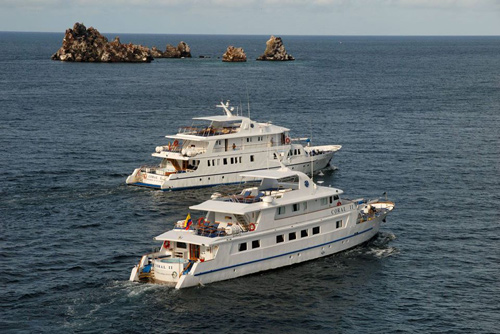
Accommodations
All nights of this trip are spent on either the Coral I or Coral II (depending on chosen departure).
The Coral I & II are gorgeous, comfortable sister yachts with four decks and a total of 18 (36 guests max) and 11 (20 guests max) cabins respectively. Both boats have been refurbished during the summer of 2019.
Each of the Coral boat has 3 different cabin categories:
- Standard Cabin (2 cabins in the Coral I)
- Standard Plus Cabin (8 cabins in the Coral I and 4 cabins in the Coral II)
- Junior Cabin (8 cabins in the Coral I and 7 cabins in the Coral II)
All cabin categories include a private bathroom (with hairdryer and toileteries), safe-deposit box, air conditioning, phone (internal calls only) and a TV.
There are cabins with interconnecting doors suitable for families or friends traveling together.
Our voltage is set for 110-220 volts/60 Hz. There are Wi-Fi zones onboard.
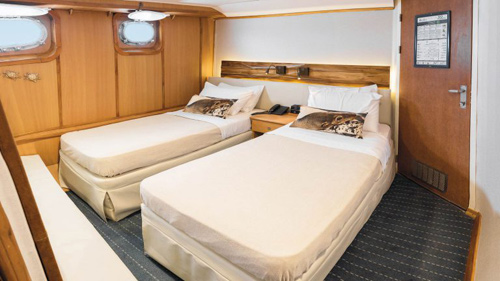
Standard Cabin - measuring an average of 7 m2 / 75ft2
Double and single occupancy possible.
There are 2 portholes in each Standard Cabin.
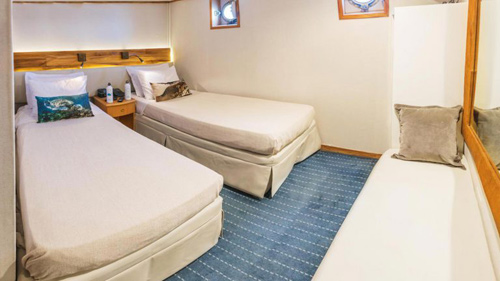
Standard Plus Cabin - measuring an average of 11 m2 / 118 ft2
Double and triple occupancy possible.
There are 2 portholes per Standard Plus Cabin.
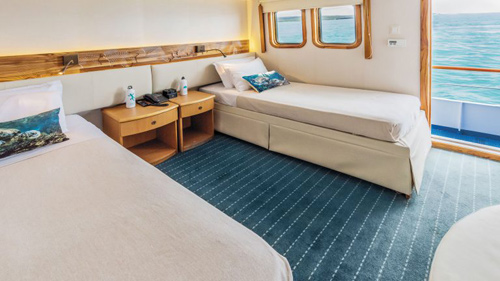
Junior Cabin - measuring an average of 12 m2 / 128 ft2
Double and triple occupancy possible.
Each Junior Cabin has 2 picture windows.
Onboard Service and Facilities include:
• Drying machines available for complimentary use
• Variety of onboard activities
• Briefings on the following day’s activities
• Informative lectures about the Galapagos
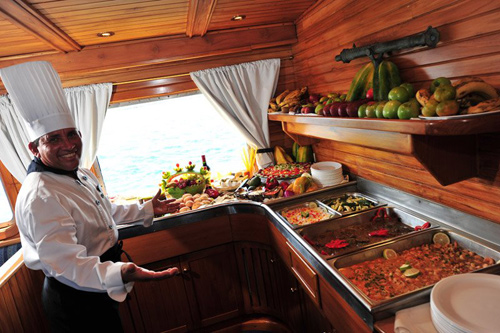
Meals
All meals are included during the cruise.
The restaurant serves delicious Ecuadorian and international cuisine that even extends to a BBQ dinner on the open-air Moon Deck.
Make the most of your cruise experience with our beverage packages (not included in tour price - to be p[aid extra) that offer a range of soft drinks, local beer, a selection of sparkling wines and classic cocktails to be served at our bars and restaurants.
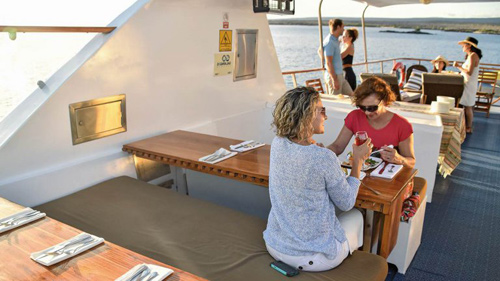
Riding
Staff
Every crew member is trained to provide a first-class service with exceptional professionalism. Genuinely friendly individuals, fully dedicated to providing the best hospitality services, with attention to detail
and personalized assistance, our crew’s passion and commitment create a one-of-a-kind experience for our guests.
Physical requirement for the cruise
We recommend that passengers be in reasonably good physical condition as some trails are difficult therefore elderly or disabled people may find them too hard. The passengers with difficulties must notify us about their physical condition in order to make the necessary arrangements.
We reserve the right to refuse a passenger if someone failed to inform of any physical disability, or who in the opinion of the company, constitutes a danger to themselves, other guest, members of the crew, or the smooth operation of the vessel.
Dry Landings and Wet Landings
On a dry landing, passengers step directly from a dinghy to rocks or onto a dock. We recommend: walking shoes, sunscreen, hat, water, insect repellent and a light jacket.
Wet Landing means that the dinghy edges up onto a beach, where you step into knee-deep water assisted by crew members and guides. We recommend: swimming suit or shorts, walking shoes or slippers, towel that will be provided by the crew while disembarking, sunscreen, hat, insect repellent, plastic bag, well insulated cameras and a windbreaker.
Smoking policy on board the ship
It is forbidden to smoke inside the yachts or the vessel.
Smoking is allowed ONLY on the sun decks.
How can I pay my expenses on board?
Upon arrival, a bill will be opened for you. If you wish to pay with your credit card, we ask you to come to reception to sign a voucher and to make copies of your passport and credit card. Authorizations take about 48 hours, so please do this on your first cruise day. We accept all main credit cards: Diners, Visa, Mastercard , American Express. Travellers Checks, Euros and US Dollars are also accepted.
What would happen if I get seasick?
We hardly get a seasick passenger on board. However, we have seasick medication on board all our ships, but if you are particularly sensitive you can bring your own medication.
Is the water safe to drink?
The tap water is generally not safe to drink in Ecuador. Bottled water is readily available at tourist sites, hotels, and restaurants. On board our yachts you will find bottled water in your room. Ice used onboard the yachts is generally made with purified water as well.
Itinerary
Sample Itinerary: Central option - subject to changes
Day 1 (Sunday): Arrival & Santa Cruz Island Visit
Departure from Quito or Guayaquil to Baltra Island (approx. 2½-hour flight). Arriving in the Galapagos, passengers are picked up at the airport by our naturist guides and taken on a ten-minute bus drive to the pier to board the M/Y Coral I or M/Y Coral II.
This afternoon, dry landing on Santa Cruz Island. We visit the Station where the Galapagos giant tortoise breeding program takes place as part of our efforts to preserve the fragile Galapagos environment and where
the famous Lonesome George (the last surviving specimen of his species) lived for decades. Admire a prickly-pear cactus forest and variety Darwin’s finches and other land birds. The Darwin Station also works providing environmental education to the communities, schools, and tourists visiting the Galapagos Islands. You will also have some free time to visit the town and shop for souvenirs.
Difficulty level: intermediate (flat terrain)
Duration: 1 ½-hour
Day 2 (Monday): Barranco & Darwin Bay (Genovesa Island)
We start the day with a dry landing on Genovesa island. Be marveled at the variety of sea life that uses the crevices of the lava cliffs for shelter. Red-billed Tropic birds fly overhead, switching between their nests and the bay, and a small colony of fur seals may be found near the landing site. You will be dropped off at a steep stairway that begins on rocks at the foot of a path that leads through a seabird colony full of Nazca and Red-footed Boobies. At the plateau, the trail continues inland allowing you to see more nesting booby colonies in the thin Palo Santo forest. Near the end of the trail, over a rocky lava plain, Wedge-rumped Storm-Petrels can be observed flying in all directions. If you are lucky, you may catch a glimpse of a Short-eared Owl.
Difficulty level: moderate (rocky - lava terrain)
Duration: 45 minute
After lunch, we have a wet landing in Darwin Bay, where we disembark onto a small sand and coral beach. A short trail heads west along a tidal lagoon and then up a rocky hill that leads to a point overlooking the cliffs and Darwin Bay. Along the trail near the tidal lagoon, visitors will see pairs of Swallow-tailed Gulls, Lava Gulls, Yellow-crowned and Lava Herons. The trail continues through Palo Santo trees, Opuntia cacti, and Saltbushes inhabited by Great Frigate birds and Red-footed Boobies. This is one of the few places in the islands where visitors are guaranteed to see Red-footed Boobies. It is estimated that more than 200,000 Red-footed Boobies live in the trees and bushes of Genovesa.
Difficulty level: moderate (sand and lava)
Duration: 2:30-hour
Day 3 (Tuesday): Rabida Island & Bartolome Island
Also known as Jervis Island in English, Rabida is one of the most diverse in terms of volcanic activity as it lies at the very heart of the archipelago’s volcanic origin. In this deep red beach, surrounded by cliffs and steep slopes of volcanic cinder cones it is usual to find nesting colonies of brown pelicans, as well as, nine species of Darwin finches, fur seals, and Nazca boobies.
Snorkel off the coast, where marine life is particularly active and colorful.
Activity Difficulty: easy (sandy terrain)
Activity Duration: 1 ½-hour walk / 1-hour snorkeling / 1-hour dinghy ride
In the afternoon, we go to visit the center of the archipelago. Bartolome is one of the most frequently visited sites of all the islands. The highest point is only 374 feet (114 m) above sea level and it has a surface area of 0.74 mi (1.2 km). The island is separated from the island of Santiago by the Sullivan Bay. It is an excellent site for snorkeling, filled with the breathtaking volcanic landscapes that make this corner of the world so unique. The first landing possibility is by a dock, made out of lava and concrete, which soon turns into a wooden staircase built to avoid erosion and consists of 372 steps. It leads to the island’s summit, where you will find what probably constitutes the most photographed site in the Galapagos: the Pinnacle Rock.
Due to its altitude, the lack of vegetation is immediately noticeable. Pioneer plants can be observed, which are called this way because they are the first to establish roots on new ground. They include Tiquilia nesiotica (which is endemic to the island) and Chamaesyce (known as sand mat or spurge in English), lava cactus, and Scalesia bushes. Behind the beach, there are dunes covered by mangroves. The second type of landing possibility is at coralline beach next to Pinnacle Rock which is a wet landing site. From this point, you will be able to snorkel among tropical fish, perhaps sea lions and penguins as they rest on the lava floors of the intertidal zone and sometimes decide to take a dip.
Disembarking:
Landing 1): dry, to trek up Summit Trail.
Landing 2): wet, to visit Bartolome Beach.
Difficulty level: intermediate (sandy volcanic ash trail and 372 step in a wooden stairway)
Duration: 1:30 hour hike, 1 hour beach time, swimming or snorkeling.
Day 4 (Wednesday): Black Turtle Cove (Santa Cruz Island) & Departure
On the north shore of Santa Cruz Island, accessible only by sea, four species of mangrove crowd form an internal lagoon: Black Turtle Cove. Turtles visit the calm waters, peaking their heads above the surface, while the fish and rays circle below. White-tipped reef sharks can be seen beneath the boat, plus seabirds including pelicans, herons, and egrets feed from the cove. This cove has been declared as a “Turtle Sanctuary.”
Activity Difficulty: easy
Activity Duration: 1-hour dinghy ride
After the visit, passengers will be transferred to the airport to their return flight to Guayaquil or Quito.
Sample Itinerary: East option - subject to changes
Day 1 (Sunday): Arrival & North Seymour Island Visit
Departure from Quito or Guayaquil to Baltra (2 ½ hours flight). Passengers are picked up at the airport by our naturalist guides and taken on a ten minute bus drive to the pier to board the Coral I or II.
In the afternoon, we do a dry landing on North Seymour Island. This is perhaps one of the busiest tourist destinations on the archipelago. Off of Baltra Island (where the airport is located) and not far from Santa Cruz, North
Seymour is the most accessible for day trips out of Santa Cruz’s main port, Puerto Ayora.
An approximately two hour walk amidst large nesting colonies of blue-footed boobies, magnificent and great frigatebirds, and swallow-tailed gulls for an in depth encounter with sea bird breeding cycles and as well as sea lions. You will also encounter sea lions, land iguanas, and on a lucky day, you might even come across a Galapagos Snake.
Difficulty level: intermediate (rocky ground)
Duration: 2-hour walk / 30-minute snorkeling
Day 2 (Monday): Breeding Center (Santa Cruz Island) & Mosquera Islet
We start the day with a dry Landing on Santa Cruz Island to visit the Charles Darwin Station and Fausto Llerena Breeding Center, where the Galapagos giant tortoise breeding program takes place as part of our efforts to
preserve the fragile Galapagos environment and where the famous Lonesome George (the last surviving specimen of his species) lived for decades. Here you will be able to see tortoises through all their stages including hatchings, juveniles, and full-grown individuals. The breeding project began in the 1970’s and has been an incredible success in helping repopulate the Galapagos Giant Tortoise population. Out of the eleven species that were once considered to be endangered species 10 subspecies of Galapagos Tortoise have been brought up to guarded levels. The most successful story is the one of the Espa ola Tortoises. When the program began, it consisted of a total population of 3 males and 11 females. As of 2008, these 13 tortoises are the parents of over 1000 young tortoises that now roam free on Espa ola. The Darwin Station also works providing environmental education to communities and schools within the islands and to tourists visiting the Galapagos Islands.
Difficulty level: easy (flat terrain)
Duration: 1 ½-hour walk
This afternoon, wet Landing on Mosquera Islet, located between North Seymour and Baltra Island. Mosquera Islet is a tectonic uplift of sands, coral reefs and rocks, located between North Seymour and Baltra Islands. This flat 0.022 mi (0.06 km ) white sand island has one of the largest colonies of sea lions. Because of this, there are occasional reports of killer whales seen around this islet. It is also an excellent site for observing shorebirds such as herons and Lava Gulls. You can also spot marine iguanas, blue footed boobies and sally light food crabs. There is no trail on Mosquera Island, so any visitor can enjoy an open area. Most of the islet is covered
with sand and barren lava rock. Very little sesuvium portulacastrum grows on the sand. It is a fun snorkeling site, just swimming off of the beach. There’s a good chance snorkelers will be joined by one or several of the numerous sea lions who live at this Island, specially the playful Young ones. An easily accessed scuba diving site, Mosquera’s maximum depth for this dive site is 30 m and currents are generally mild. This site is famous for the sea lions that come and play during the dive. Sharks, turtles, rays, barracudas and tropical fish are common in this area
Activity Difficulty: easy (sandy terrain)
Activity Duration: 1 ½-hour walk & snorkeling
Day 3 (Tuesday): Santa Fe Island & South Plaza islet
After breakfast, wet landing. Santa Fe shows white sand beaches surrounded by sea lion colonies; through the island path, an endemic cactus forest is passed, home the Santa Fe land iguanas (the largest in the islands). This island is the habitat for a number of species, including the Galapagos hawk, Galapagos snakes, rice rats (one of the few endemic Galapagos rodents), a variety of finches and one of the four mockingbird species of the archipelago.
Activity Difficulty: intermediate (rocky terrain)
Activity Duration: 1 ½-hour walk / 1-hour deep-water snorkeling
In the afternoon, dry landing on the northern part of the Islet. The walk begins with an impressive cactus forest* surrounded by land and marine iguanas; as we reach its highest point, be on the lookout for tropicbirds, a Nazca and blue-footed boobies, swallow-tailed gulls.
In South Plaza there is a large colony of the smaller sized land iguanas. Approximately, there is a population of 300 individuals. They feed on all kinds of vegetation, but during the dry season survive on the fruits and flowers of Opuntia cacti. Due to their proximity with marine iguanas, this is the only place on Earth where we will find the Galapagos hybrid iguana.
Activity Difficulty: intermediate (rocky terrain)
Activity Duration: 2-hour walk
Day 4 (Wednesday): Lobos Island & Departure
This morning, wet landing on Isla Lobos, approximately 20 minutes by boat from Puerto Baquerizo Moreno. The length of the trail is 850 meters, and the estimated travel time is one hour. There is a small population of blue-footed boobies and common frigatebirds nest at this site. You can see the two species of sea lions present in the Archipelago. During the boat ride, you can see brown pelicans several species of shorebirds.
Difficulty level: easy
Duration: 1:30 - hour walk
After the visit, you will go to San Cristobal Airport for the return flight to Guayaquil or Quito.
Rates and Dates for Coral 4-day Cruise
Rates include:
Accommodation, All meals, Welcome & farewell cocktails, Coffee / tea station, 2 daily excursions, Multilingual naturalist guides (English/Spanish), Snorkeling opportunities, Optional Diving, Fuel surcharge, Free Shuttle service from Quito/Guayaquil Airport-roundtrip (when domestic flight is purchased in combination with cruises)
Guides speaking French, German and Italian upon request
Rates Note:
The transit card fee and the Galapagos entrance fee must be paid to the CGG (Consejo de Gobierno de Galapagos) at the airport in cash.
* prices are per person based on double/twin occupancy
Rates Note:
The transit card fee and the Galapagos entrance fee must be paid to the CGG (Consejo de Gobierno de Galapagos) at the airport in cash.
Transfer and Other Charges:
|
2021
|
Air ticket from Quito/ Guayaquil to Galapagos, per adult, roundtrip
|
$540
|
|
2021
|
Transfer from Quito/ Guayquil Airport- roundtrip (if airfare not booked) (Mandatory)
|
$90
|
|
2021
|
Single Supplement: +50% on standard (+75% on holiday season)
|
$0
|
|
2021
|
Child (Under 12): -50% discount (-25% during the holidays) when sharing room with 2 full-fare paying adults
|
$0
|
|
2021
|
Triple room discount: -25% for third person sharing with 2 full-fare paying adults
|
$0
|
|
2021
|
CGG Migration Card (mandatory), pp
- to be paid locally
|
$20
|
|
2021
|
Entrance fee to Galapagos (mandatory), per adult
- to be paid locally
|
$100
|
|
2021
|
Entrance fee to Galapagos (mandatory), per child under 12
- to be paid locally
|
$50
|
|
2021
|
Holiday supplement (Jan 1-5 & Dec 18-31): +5%
|
$0
|
Dates Note:
Weekly departures Sunday to Wednesday
Rates do not include:
Drinks, Air ticket from Quito/ Guayaquil to Galapagos (can be booked for extra fee), Galapagos Entrance Fee (mandatory), CGG Migration Control Card (mandatory), Gratuities, Travel insurance, Gratuities, Snorkelling / diving equipment & Wet suits / kayak rentals
Other Info
Meeting: Baltra
Airport: Baltra
Transfer: Baltra
Climate:
Galapagos area
|
Month
|
Jan
|
Feb
|
Mar
|
Apr
|
May
|
Jun
|
Jul
|
Aug
|
Sep
|
Oct
|
Nov
|
Dec
|
|
Average High Temperature (°F)
|
86
|
86
|
88
|
88
|
79
|
79
|
79
|
79
|
79
|
81
|
82
|
84
|
|
Average Low Temperature (°F)
|
72
|
75
|
75
|
75
|
72
|
70
|
66
|
66
|
66
|
68
|
70
|
72
|
|
Average High Temperature (°C)
|
30
|
30
|
31
|
31
|
26
|
26
|
26
|
26
|
26
|
27
|
28
|
29
|
|
Average Low Temperature (°C)
|
22
|
24
|
24
|
24
|
22
|
21
|
19
|
19
|
19
|
20
|
21
|
22
|
Source: www.galapagosislands.com
Seasons
You will be in a sunny year round destination; the warmest months are from December to April. January to March can be hot and humid, but also mostly green at this time. The months from July to November are cooler. The average year-round temperature is 24°C. (76°F).
Galapagos Dry Season (June to December)
From June to December the southern trade winds bring the colder Humboldt Current north to the Galapagos. This means that the water is cooler, and a layer of high atmosphere mist pervades the island skies. In effect, the highlands of the larger islands are kept green and lush while the sea level islands and shorelines have little precipitation. Thus, June to December is generally called the "dry season" which is known for its blue skies and mid-day showers.
During this season the tourists may observe a large number of species around the islands and in the sea such as giant tortoises, humpback whales, blue-footed boobies, cormorants, oyster catchers, lava lizards, Galapagos hawks, masked boobies, swallow-tailed gulls, sea lions, lava herons, brown noddies, and penguins. Due to the water temperature, it is the perfect time for diving.
Galapagos Wet Season (December to May)
This period is considered the "wet (warm) season." During this warmer season, the Galapagos' climate is more tropical with daily rain and cloudier skies. Also, the ocean temperature is warmer for swimming and snorkeling
During this season the tourists may observe a large number of species around the islands such as marine iguanas, sea turtle, land iguanas, flamingos, white-cheeked pintails, masked boobies, marine iguanas, albatross, and blue-footed boobies. Since the water's warmer, snorkeling is highly recommended during these months.
Special note - Galapagos Weather for Divers
The Humboldt Current's influence brings cold waters especially during the misty, rainy season (cool weather) from July to December. "El Niño" current may bring warm waters to the Galapagos and will make the surface warmer and rainfall increase (January to June).
The water temperature varies during the year:
January to June: from 70°F (21°C) to 80°F (27°C)
July to December: from 65°F (18°C) to 75°F (23°C)
What To Bring:
We advise you to bring comfortable breathable clothes; shorts, T-shirts, swimsuits and good hiking shoes are required to walk over the lava rock paths, personal medication, a good camera and plenty of memory sticks or film, sun block, sunglasses, binoculars. It is also a good idea to bring water shoes or sport shoes that can be wet, for the wet landings.
Galapagos means nature, moving, enjoying and relaxation, therefore you don’t have to worry about dressing up. Casual and light clothing is recommended on board the ship.
For dinning: you will need a semiformal wear and a sweater or jacket for windy nights.
For shore excursions comfortable clothing is a must, preferably shorts, bathing suits, head covering, walking shoes, tennis shoes, windbreaker type jacket, binoculars, camera and plenty of film. Sun rays are very strong in the Galapagos Islands. Do not forget to take with you enough high grade sun block. Also, put your cameras in self-sealing plastic bags to protect them from the water, especially during landfalls.
Internet is not available yet, but you can always get internet in Puerto Ayora and San Cristóbal.
|
|